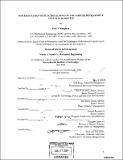Implementation of functional build in the vehicle development and launch process
Author(s)
Haughton, Peter T. (Peter Torgil), 1970-
DownloadFull printable version (6.272Mb)
Other Contributors
Leaders for Manufacturing Program.
Advisor
Daniel Whitney and Jan Klein.
Terms of use
Metadata
Show full item recordAbstract
Prior to production of an automotive assembly, the individually fabricated components must be validated or "tuned in" in order to produce an acceptable assembly. This validation or tune in process must be done before the product can be sold, and is generally a major step in the launch process. Mean shifts and variance within normal production processes result in differences between design intent (specifications) and actual parts. These differences are unavoidable in most processes. During launch processes manufacturers must have strategies for dealing with these differences. One traditional strategy to product launch processes is build-to-print methodology. The basic assumption of this methodology is that by working to make individual parts as close as possible to specification, the assemblies of these parts will also be to specification. In others words one can achieve an optimized assembly by focusing on the individual parts. An alternate methodology to build to print is functional build. A functional build methodology involves focusing on the completed assembly rather than the individual parts. The basic idea is to examine if the overall assembly meets customer requirements. If it does not then the launch team can analyze the individual parts to determine the best way to solve the problem. This solution may or may not involve forcing a part to design intent. In the recent past a major American auto manufacturer has used functional build methodology in the tune-in of the body structures. This auto manufacturer is currently implementing a change to vehicle development process called the craftsmanship initiative. A major part of the craftsmanship initiative involves extending the functional build methodology to a higher level of assembly. (cont.) Functional builds will be extended to include not only body structures but also interior and exterior parts typically installed on a typical vehicle assembly line. This thesis will first examine both the technical and corporate reasoning behind this fundamental change to one of the core processes within the auto manufacturer. Second the thesis will study the underlying challenges surrounding implementation of this change and recommend possible solutions to some of these challenges. The major focus of the internship has been participation on the pilot program that is implementing this change. There are three main areas of difficulty facing the pilot program. These are process design issues, organization structure challenges, and development of appropriate metrics to measure the impact of the change.
Description
Thesis (M.B.A.)--Massachusetts Institute of Technology, Sloan School of Management; and, (S.M.)--Massachusetts Institute of Technology, Dept. of Mechanical Engineering; in conjunction with the Leaders for Manufacturing Program at MIT, 2004. Includes bibliographical references.
Date issued
2004Department
Leaders for Manufacturing Program at MIT; Massachusetts Institute of Technology. Department of Mechanical Engineering; Sloan School of ManagementPublisher
Massachusetts Institute of Technology
Keywords
Sloan School of Management., Mechanical Engineering., Leaders for Manufacturing Program.